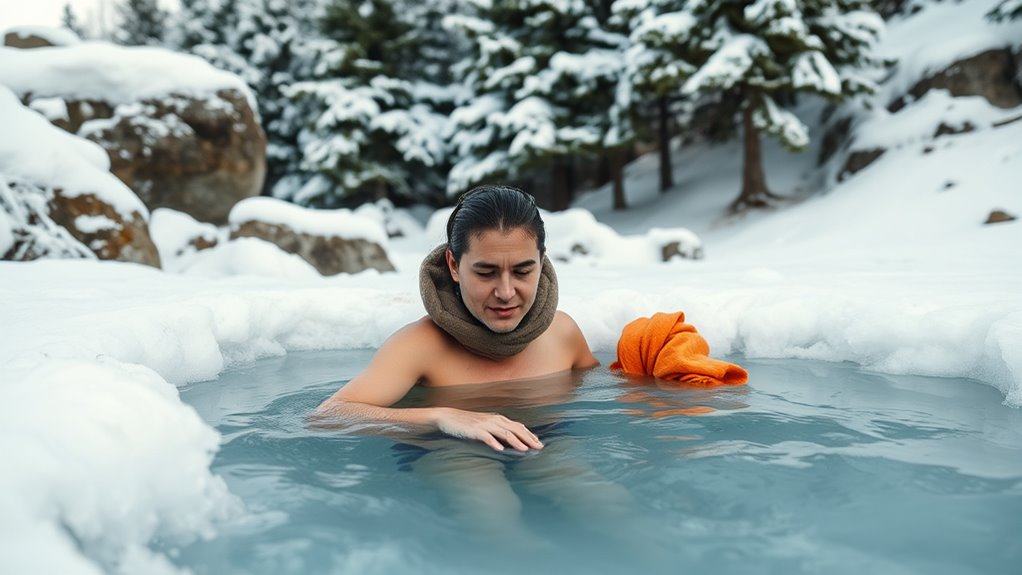When taking a cold plunge, always check the water temperature beforehand and start with short immersions of 1-2 minutes. Never go alone—have someone nearby to help if needed—and enter gradually to avoid shock. Watch for signs like uncontrollable shivering or numb lips, and exit immediately if you experience discomfort. To stay safe, warm up gradually afterward and stay aware of your body’s signals. Continue exploring essential tips to stay protected during cold exposure.
Key Takeaways
- Always check water temperature and start with short immersions to allow your body to adapt gradually.
- Never plunge alone; have a companion nearby to assist if signs of hypothermia or shock occur.
- Monitor for signs like uncontrollable shivering, numbness, or blue lips, and exit immediately if symptoms appear.
- Warm up slowly with dry clothes and blankets after immersion; avoid hot showers immediately to prevent heart stress.
- Focus on steady breathing, stay calm, and listen to your body to prevent panic and reduce risk of hypothermia and shock.

Taking a cold plunge can be invigorating, but it’s essential to prioritize safety to avoid risks like hypothermia or shock. When you dive into cold water immersion, your body is suddenly exposed to low temperatures, which can challenge your ability to regulate your core temperature. Proper temperature regulation is crucial; if the water is too cold or if you stay submerged too long, your body may struggle to maintain a safe internal temperature, increasing the risk of hypothermia. To prevent this, always check the water temperature beforehand. Ideally, for beginners, water should be between 50°F and 60°F (10°C-15°C). If you’re experienced and know your limits, you can go colder, but never push yourself beyond comfort or safety.
Always check water temperature first; stay within safe limits to prevent hypothermia during cold plunges.
Before you immerse yourself, take a moment to plan your cold water immersion carefully. Start with shorter durations—just a minute or two—and gradually increase as your body adapts. Pay attention to how your body responds, especially your breathing and heart rate. If you start shivering uncontrollably, feel numbness, or your lips turn blue, it’s time to get out immediately. Remember, the key is to listen to your body. Don’t ignore early signs of trouble, as they can escalate quickly in cold water. Additionally, understanding how automation technologies can assist in safety monitoring is increasingly relevant in cold plunge practices.
It’s also vital to have someone nearby when you plunge, especially if you’re new to cold water immersion. Never do it alone, because if you experience shock or difficulty controlling your breathing, having assistance nearby can be lifesaving. Always enter the water gradually, easing your body into the cold instead of jumping straight in. This helps your body acclimate to the abrupt temperature change and reduces shock risk. Once submerged, keep your head above water if possible and avoid panicking, which can cause hyperventilation or rapid heartbeat. Focus on controlled, steady breaths to help manage the body’s response to the cold.
Post-immersion safety is equally important. Warm up gradually afterward with dry clothes, blankets, or warm drinks. Avoid hot showers immediately after, as sudden temperature shifts can cause additional stress on your heart. Hydrate well, and if you experience persistent numbness, dizziness, or confusion, seek medical attention promptly. Proper planning, gradual exposure, and attentive listening to your body’s cues are the best strategies to enjoy cold water immersion while minimizing risks. By respecting these safety tips, you can harness the benefits of cold plunging safely and confidently.
Frequently Asked Questions
Can Cold Plunges Improve Mental Health?
Cold plunges can definitely improve your mental health by boosting mood and reducing stress. When you immerse yourself in cold water, your body releases endorphins, which enhance feelings of well-being. This practice can also help clear your mind and increase mental resilience. Regular cold plunges may contribute to long-term mood improvement and better overall mental health, making them a worthwhile addition to your wellness routine.
How Long Should Beginners Stay in Cold Water?
As a beginner, you should start with a duration of 1 to 3 minutes in cold water. Follow duration guidelines closely to prevent hypothermia and shock. Always listen to your body and exit immediately if you feel uncomfortable or numb. Precautions include gradually acclimating yourself and not exceeding your limits. Over time, you can slowly increase your time, but always prioritize safety and never push beyond your comfort zone.
Are There Any Long-Term Health Risks?
While cold plunges offer benefits, long-term effects and chronic risks aren’t fully understood yet. You might worry about potential impacts on your immune system or cardiovascular health over time. Some studies suggest that repeated cold exposure could increase stress on your heart or cause nerve issues, especially if done improperly. Stay cautious, listen to your body, and consult a healthcare professional to balance the benefits with potential chronic risks.
What Should I Do if I Feel Dizzy?
If you feel dizzy during a cold plunge, stop immediately and exit the water to prevent injury. Focus on dizziness management by sitting or lying down in a warm, safe area. If symptoms persist or worsen, seek emergency response by calling for medical help. Always listen to your body, and don’t push through dizziness, as it can indicate hypothermia or shock risk. Your safety comes first.
Is Cold Plunging Safe During Pregnancy?
During pregnancy, cold plunging isn’t safe because cold exposure can cause stress and unpredictable reactions that might harm you or your baby. While you might enjoy the invigorating shock of cold water, it’s better to avoid it during pregnancy. Always prioritize your pregnancy safety by consulting your healthcare provider before trying any cold exposure activities. Protect your health and your baby’s by choosing safer alternatives.
Conclusion
Remember, a cold plunge is like a rollercoaster—thrilling but best enjoyed when you know how to stay safe. Always listen to your body, limit your time in the water, and have a warm towel nearby. By following these tips, you’ll avoid turning your icy adventure into a dangerous dive. Stay smart, stay safe, and let the chill invigorate your day—just don’t let it catch you off guard!









